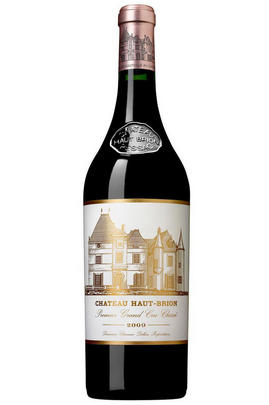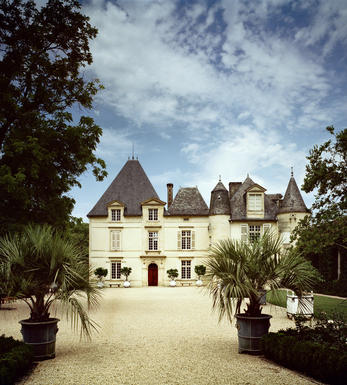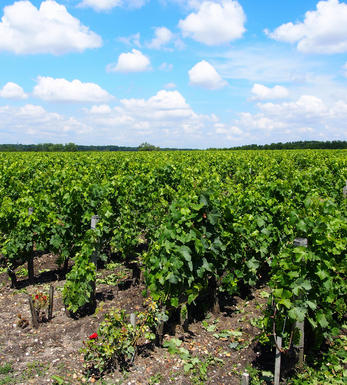
2010 Château Haut-Brion, Pessac-Léognan, Bordeaux

Critics reviews
The 2010 Haut-Brion has a more flamboyant and showier bouquet than the La Mission with copious black fruit, orange blossom, fireside ash and chai tea aromas that are irresistible. The palate is medium-bodied with very fine and supple tannins, firm grip, quite saline in the mouth with strong truffle notes on the finish. Quite brilliant. Tasted from an ex-château bottle at the BI Wines & Spirits 10-Year On tasting.
Drink 2026-2080
Neal Martin, vinous.com (Apr 2020)
Deep garnet in color, the 2010 Haut-Brion charges out of the gate with exuberant notes of crème de cassis, blueberry pie and baked plums followed by nuances of dark chocolate, licorice and cloves. Full-bodied, the palate has lots of subtle earth and mineral accents with a firm, finely grained texture and great freshness lifting the long finish.
Lisa Perrotti-Brown, Wine Advocate (Mar 2020)
A little less dramatic than La Mission 2010 on the nose. Savoury and a bit low key but velvety textured and with masses there. Really very exciting with mass and pace. A great Haut-Brion with such energy and savour.
Jancis Robinson, jancisrobinson.com (Jan 2020)
Sappy, tongue-coating pastis, blackberry coulis and loganberry fruit starts this huge wine off, followed by a parade of licorice snap, violet, tar, black tea, roasted alder, wood spice and steeped black cherry fruit notes. A beam of pure cassis drives through this, and the finish pulls everything together with a mouthwatering brambly edge that should soften slowly over time. A riveting display of brawny power, unbridled energy and high-level terroir. Best from 2020 through 2040. 7,800 cases made.
James Molesworth, Wine Spectator (Mar 2013)
As for the 2010 Haut-Brion, it does not have the power of Latour’s 2010 or the intense lead pencil shavings and chocolaty component of Lafite-Rothschild, but it is extraordinary, perfect wine. It has a slightly lower pH than the 2009 (3.7 versus the 2009's 3.8), and even higher alcohol than the 2009 (14.6%). The wine is ethereal. From its dense purple color to its incredibly subtle but striking aromatics that build incrementally, offering up a spectacular smorgasbord of aromas ranging from charcoal and camphor to black currant and blueberry liqueur and spring flowers, this wine’s finesse, elegant yet noble power and authority come through in a compelling fashion. It is full-bodied, but that’s only apparent in the aftertaste, as the wine seems to float across the palate with remarkable sweetness, harmony, and the integration of all its component parts – alcohol, tannin, acidity, wood, etc. This prodigious Haut-Brion is hard to compare to another vintage, at least right now, but it should have 50 to 75 years of aging potential.
Robert Parker, Wine Advocate (Feb 2013)
Another different register as we head to Pessac-Léognan. And as with Mouton this has an exuberant grilled almond note around the edges with a thick velvety texture. You can really feel the weight and width of this wine through the mid palate and again you feel it just has so much life and pleasure ahead of it. This is all about the texture, it has an extremely marked sense of a rising tide of tannins and fruit, ready to power through the ages.
Jane Anson, decanter.com (Jan 2020)
The driest summer at Haut-Brion since 1949 made life difficult for the young Merlot vines, but helped the Cabernet to achieve unprecedented ripeness. According to Jean-Philippe Delmas, the grand vin has the highest levels of tannin, alcohol and colour ever recorded. The result is brilliant: powerful, dense and voluptuous with plenty of plum, cassis and black cherry fruit to wrap around the wine’s core of tannin and acidity. A mere whisker away from perfection and a legendary Haut-Brion in embryo.
Tim Atkin MW, timatkin.com (May 2011)
About this WINE

Chateau Haut-Brion
The only property from outside the Médoc to be included in the 1855 Classification, Haut-Brion’s viticultural history can be traced back further than its Médoc First Growth counterparts. Samuel Pepys even mentions it in his diaries. Situated in what is now Pessac-Léognan, the property finds itself now in the suburbs of the ever-encroaching city of Bordeaux.
After falling into a state of disrepair the estate was purchased in 1935 by Clarence Dillon, an American financier, since when it has enjoyed a steady and continual resurgence to a position of pre-eminence. Dillon’s great-grandson, Prince Robert of Luxembourg, now runs the estate, but a key influence in the reputation which Haut-Brion enjoys today is the Delmas family. George Delmas was manager and wine-maker until 1960, when his son Jean-Bernard took over. Jean- Bernard was a visionary figure, responsible for a number of important innovations, and on his retirement in 2003 his son Jean-Philippe took over as Directeur Générale.
The vineyard is planted to 40% Cabernet Sauvignon, 37% Merlot and 18% Cabernet Franc. A stunning white wine is also made, from a part of the vineyard which is 63% Semillon and 37% Sauvignon Blanc. Production is smaller than at the other First Growth Wines, totalling about 20,000 cases, shared between the Grand Vin and a second wine, formerly called Bahans-Haut-Brion but changed in 2007 to Clarence de Haut-Brion in recognition of Clarence Dillon. Production of Haut Brion Blanc is minute, less than 800 cases in most years.
Beginning with the 2009 vintage a new white wine was introduced in the place of Clarence: La Clarté de Haut-Brion, the offspring of Domaine Clarence Dillon's two prestigious white wines: Château Haut-Brion Blanc and Château La Mission Haut-Brion Blanc.
Fermentation of the red wines takes place in stainless steel vats, after which the wine will spend 22 months, sometimes more, in new oak barrels before being bottled unfiltered. For the white wine fermentation takes place in new oak barrels, after which the wine spends a further year to 15 months on its lees in barrel before bottling. The white wine is truly sensational, equivalent in class to a top-flight White Burgundy Grand Cru, but its scarcity means that it is rarely seen.
The red wine is no less extraordinary; at its best it displays text-book Graves characteristics of cigar-box, curranty fruit, earth, smoky spice and cassis. The high Merlot content, compared to the Médoc First Growths, gives it a voluptuous edge, but does not in any way detract from its ability to age.

Pessac-Leognan
In 1986 a new communal district was created within Graves, in Bordeaux, based on the districts of Pessac and Léognan, the first of which lies within the suburbs of the city. Essentially this came about through pressure from Pessac-Léognan vignerons, who wished to disassociate themselves from growers with predominately sandy soils further south in Graves.
Pessac-Léognan has the best soils of the region, very similar to those of the Médoc, although the depth of gravel is more variable, and contains all the classed growths of the region. Some of its great names, including Ch. Haut-Brion, even sit serenely and resolutely in Bordeaux's southern urban sprawl.
The climate is milder than to the north of the city and the harvest can occur up to two weeks earlier. This gives the best wines a heady, rich and almost savoury character, laced with notes of tobacco, spice and leather. Further south, the soil is sandier with more clay, and the wines are lighter, fruity and suitable for earlier drinking.
Recommended Châteaux: Ch. Haut-Brion, Ch. la Mission Haut-Brion, Ch. Pape Clément, Ch Haut-Bailly, Domaine de Chevalier, Ch. Larrivet-Haut-Brion, Ch. Carmes Haut-Brion, Ch. La Garde, Villa Bel-Air.

Cabernet Sauvignon Blend
Cabernet Sauvignon lends itself particularly well in blends with Merlot. This is actually the archetypal Bordeaux blend, though in different proportions in the sub-regions and sometimes topped up with Cabernet Franc, Malbec, and Petit Verdot.
In the Médoc and Graves the percentage of Cabernet Sauvignon in the blend can range from 95% (Mouton-Rothschild) to as low as 40%. It is particularly suited to the dry, warm, free- draining, gravel-rich soils and is responsible for the redolent cassis characteristics as well as the depth of colour, tannic structure and pronounced acidity of Médoc wines. However 100% Cabernet Sauvignon wines can be slightly hollow-tasting in the middle palate and Merlot with its generous, fleshy fruit flavours acts as a perfect foil by filling in this cavity.
In St-Emilion and Pomerol, the blends are Merlot dominated as Cabernet Sauvignon can struggle to ripen there - when it is included, it adds structure and body to the wine. Sassicaia is the most famous Bordeaux blend in Italy and has spawned many imitations, whereby the blend is now firmly established in the New World and particularly in California and Australia.


Buying options
Add to wishlist
Description
The 2010 Haut-Brion has a more flamboyant and showier bouquet than the La Mission with copious black fruit, orange blossom, fireside ash and chai tea aromas that are irresistible. The palate is medium-bodied with very fine and supple tannins, firm grip, quite saline in the mouth with strong truffle notes on the finish. Quite brilliant. Tasted from an ex-château bottle at the BI Wines & Spirits 10-Year On tasting.
Drink 2026-2080
Neal Martin, vinous.com (Apr 2020)
wine at a glance
Delivery and quality guarantee